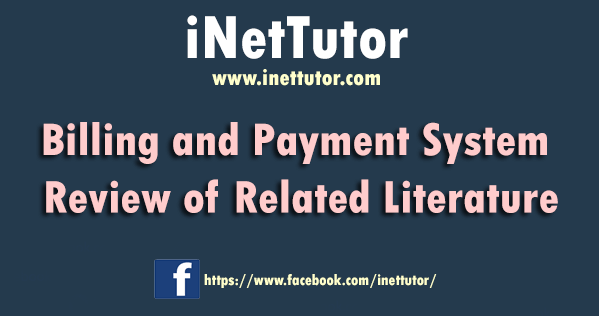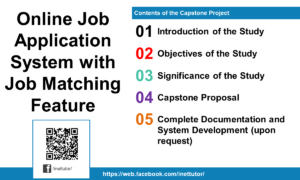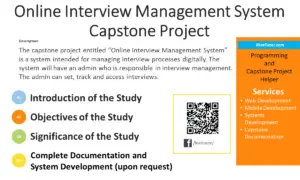Billing and Payment System Review of Related Literature
Foreign Literature
Telecommunication Billing System
According to Matem Mostafa (2005) the telecommunication companies need an effective and accurate billing system to be able to assure their revenue. Billing systems process the usage of network equipment that is used during the service usage into a single Call Detail Record (CDR). The billing process involves receiving billing records from various networks, determining the billing rates associated with the billing records, calculating the cost for each billing record, aggregating these records periodically to generate invoices, sending invoices to the customer, and collecting payments received from the customer.

Billing system is very complex starting from network elements that generate usage to the billing system to usage collection, mediation, rating, and invoicing. The system user navigates through the company site and views company services, and he decides to order one of the available services. If he has no account, then he signs up for a new account, else he signs in. Then the user asks to conduct an order with the selected service. The service may be prepaid where he has to pay to have credits to use the service, or it may be postpaid, where he has to pay if the service has installation or set fees, and later on he will pay for his usage of each billing cycle.
The billing system should provide service to the user, collect user usage records, and generate invoices of each expired credit or due credit, each billing cycle depends on the billing type, collect payments and adjust customers’ balances.
Service is the entity offered by the company and targeted to the customers. Each service is defined by an engineering employee as a service catalog which includes service type, name, billing policy, and its default rating profile. After service ordering by the customer, it takes a unique attached with the account of the customer, provided by the provisioning system to the customer at a certain date.
The customer account includes customer contact profile information, account type, login information, and payment method. Each customer account is linked in the system with specific services offered to this customer, and the customer will be billed depending on his usage of these services. Customer account belongs to a specific account type, which is related to some price plans determined by discounts and promotions. (http://www.codeproject.com/Articles/10824/Billing-System-Introduction)
The system can be applied on the Lending and Cooperatives with regards to their user account system. The log-in page is applicable to assigned personnel assign only. The Lending and Cooperatives have different personnel; the admin can only access the assigned task given to him. The manager will review all the records that are being done during the weekly fellowship.
Mortgagee Billing and Payment System
According to the article on the internet “Mortgagee Notification Billing and Payment” the state farms delivers electronic documents and accepts electronic remittance to all lenders, loan servicers, and servicing bureaus that accept the mortgagee notification, billing and payment national standard. The national implementation guide for this standard can be acquired at Washington Publishing Company.
With the help of lenders, lending servicers, vendors, and insurers, a national standard was developed allowing insurance notifications to be conveyed electronically to lenders. The Mortgagee notification, billing and payment standard was created by the policy administration work group of the accredited standards committee and sanctioned by the American National Standards Institute and the Mortgage Bankers Association.
State Farm supports the industry’s national standard for communicating information affecting our hazard insurance policies. Because of the volume of notifications in the insurance industry, State Farm has developed automated tools to ensure each lender can have its interests protected by our insurance.
There are six specific notifications that can be sent electronically by State Farm using the 811 consolidated invoice transaction set as defined in the mortgagee notification, billing and payment implementation guide. They are new business, renewal, policy change, endorsement, cancellation, reinstatement and verification.
Each of these notifications can be delivered electronically, on paper, or both electronically and on paper at the lenders’ discretion. Exchanging electronic notifications with State Farm should be a daily process, due mainly to the sensitivity of certain notices like cancellations and reinstatements; however, the ability of lenders to receive combined renewals and policy changes/endorsements will be maintained on a weekly basis.
Any notification received electronically from State farm with a balance due can be paid electronically using the 820 payment/order remittance advice transaction set as defined in the mortgagee notification, billing and payment implementation guide. Along with the payment amount, a number of reason codes can be attached, such as notice to bill the insured, payment forthcoming, or loan paid in full. (https://b2b.statefarm.com/b2b/roles/unsecured/ml/overviews/mortgage-notification-billing-payment/index.shtml)
Lending and Cooperatives are engaged in billing and payment system in lending business. The proposed system can be applied on the renewal of the members. It can also verify the payments of the members. With regards to its payments it can help the staff to know the balance and due date of the member. In relation to the safety of the records, it can help the system secure the records because not all the personnel can access all the records.
Departmental Store Billing System
According to K. Anjana, B Anjana, S. Jain the project billing system is an application to automate the process of ordering and billing of a departmental store .This web based application is designed considering the chain of departmental store which is located in various cities. This application also administrates its users and customers.
The company has been facing the problem of inconsistent and out of time information in its activities. Excessive time is consumed for report generation, which is not very helpful for decision making.
The proposed system provides managing of huge data effectively and efficiently for efficient results, storing the details of the customers, employees etc. in such a way that the database can be modified. The proposed system is user friendly because the retrieval and storing of data is fast and data is maintained efficiently. Moreover the graphical user interface is provided in the proposed system, which provides user to deal with the system very easily. Reports can be easily generated in a proposed system. So any type of reports can be generated in a proposed system, which helps the managers in a decisions making activity. Data can be shared in the proposed system. This means that two or more persons can use the same data in existing system provided that they have the right to access that data. Also, two or more departments in the organization can easily interact with each other without the actual movement of data. The proposed system either does not require paper work or very few paper works are required. All the data is feted into the computer immediately and various bills and reports can be generated through computers. Since all the data is kept in a database no data of the organization can be destroyed. Moreover work becomes very easy because there is no need to keep the data on papers. Proposed system supports strategic competitive advantages. Since the proposed systems provide easiness in reports generating it will provide strategic advantages among competitors. Computer operator control will be there no errors. Moreover storing and retrieving of information is easy. So work can be done speedily and in time. (http://www.iisjaipur.org/iiim-current-08/mca_iv_sem_pro_eva/04.project-billing%20system.pdf)
The Lending and Cooperatives can use the system to have a consistent and accurate information regarding the billing and payment of the member. The system can track all the records of the members. The user has different functions in the system with its different limitations to access the system. Using this system can help minimize the use of papers, time and effort of the personnel.
Local Literature
Supermarket Billing System
According to Aggrawal, Sisodia to make the software fast in processing, there should be good user interface so that user can change it and it should be used for a long time without error and maintenance. Many supermarkets use this type of billing system for a decade. It is also improved many times according to requirements of sellers and customers. It does the same work that is calculating the bill; gives it to the customer and maintain proper database. They are accurate in calculation and printing, they also generate records.
A new concept is also added in the billing system that also maintains relationships with the customers who purchase more products from the store regularly. The system also concerns their requirements and gives them more commission. It also shows the overall profit, specific profit on a particular product and reports on which items are required and which have crossed their expiry date.
Work in the Supermarket will be done in the following way:
The product will come in the store. Data entry operator will enter the information of the product in the database. The Administrator will enter the taxes and commissions for each product. The customer will come and take the basket with his/her and choose the product and take it to the counter. The bill calculating operator will check the products with the bar code detecting machine. Next then it will match with product-id which show, its information and price. Then, the bill will be calculated and total payment will show. Customer will pay for the products. Lastly all the products will be packed and delivered to the customer.
This module is made for the login of users. We know that we have 3 different users. The Log-in-ID is for: administrator, data entry operator and bill calculating operator. This module is for administrator who will set the taxes and the commissions for the products. In order for him to generate or check the report of the product and how many products are sold on particular date or in a period of time. Next this module is also for the data entry operator who will enter which products come in the store. Prices and expiry date of the product. Third module is also for bill calculating operator who will calculate the bill and print it. (http://www.iisjaipur.org/iiim-current-08/mca_iv_sem_pro_eva/17.Project-SuperMarket%20Billing%20system.pdf )
The Lending and Cooperatives can use this system to give bills to the member. It can use different users in one system in different times, provided there is limitation in every personnel. Only the admin is allowed to add and edit the profile of the member. The systems will automatically calculate the total payments of the member and it will show on the accounts.
Philippine Payment System
According to Mario B. Lamberte it is commonly known that a country’s infrastructure system determines to a large extent the efficiency of the economy. In a modern economy, the payment system is a major component of the country’s infrastructure system. Indeed, no country nowadays can afford to take its payment system for granted. Firms pay wages of their employees and purchase raw materials from their suppliers. In turn, they receive payments for the sale of their products and services. Consumers make payment transactions several times in a day. Needless to say, its value is transferred among participants in the economy every minute of the day, and it increases as the economy grows. The country’s payment system, therefore, must be efficient so that funds can quickly move among market participants for productive use, thereby promoting more activities in the economy. The resource cost of a nation’s payment system can account for 3 percent of its GDP. Modernizing a country’s payment system can certainly reduce that resource cost. Thus, while the country continues to spend on roads, bridges, power supply, etc., it must not neglect to invest in its payment system to improve the efficiency of the economy, in general, and the financial system, in particular.
Through the years, payment systems have considerably changed as forms of payment have evolved from precious metals to currency and checks and recently to electronic payments. These changes have been made because of the need to facilitate voluminous transactions occurring in rapidly growing and increasingly more sophisticated economies. Customers naturally seek the most efficient payment method, while providers of payment services normally seek the most profitable payments system. Advances in information technology and changes in laws, institutions and regulations in some countries have encouraged the emergence of new payment instruments as well as the delivery and processing arrangements for small and large value, time-critical payments. With e-commerce now in the mainstream of economic activities, we can therefore expect more major changes in the payment systems worldwide in the next five years than we have in the last five decades. Obviously, the Philippines cannot escape from these demands. Developments in the payment system have implications for the conduct of monetary policy. Well-functioning financial markets can improve the effectiveness of indirect instruments of monetary policy because it is through these markets that the signal of monetary policy is transmitted to the intermediate and ultimate targets of the policy (Johnson et al. 1998). The effective functioning of the financial market is, in turn, affected by the extent of the efficiency of the country’s payment system. Also, rapid innovations taking place in the country’s payment system can unpredictably alter the demand for and supply of money, thereby affecting the effectiveness of conventional monetary tools. Monetary authorities, therefore, cannot afford to be indifferent to the rapid innovations taking place in the payment system. (http://www.pids.gov.ph/dp.php?id=1278&pubyear=2001)
This system can help the Lending and Cooperatives on its payments system. The modernization of technology can help to secure the records of the members. The manager will check the transactions that are made in the system.
Local Community Hospitals System
According to the article in the internet “Local Community Hospital System” today, computerization is a major advancement in technology that helps in many ways: it makes information storage easier and faster thus it can save a lot of time and manpower, and many tasks are done in a certain amount of time.
Great amount of time is being consumed by information retrieval and billing process of most Local Community Hospitals without computer generated system. To be able to provide the medical needs of the rapidly growing population, Local Community Hospitals must be responsive to the current trends and innovation in today’s changes in technology.
One of the concerns of Local Community Hospitals nowadays is how to lessen the number of paper works in the transaction of the patient that could fasten the process of admission, discharging and billing of a patient. This greatly affects the profitability of the institution that makes the admission and billing of patients a long process.
Another concern of Local Community Hospitals nowadays is how to lessen the number of paper works in the transaction of the patient in order to fasten the process of admission, discharging and billing of a patient.
Therefore the general objective of the study is to develop a computerized patient monitoring and billing system, for the medical institution Local Community Hospitals to fasten the admission and discharging process of patients, and to provide automatic computation of one’s patient bills. (http://voices.yahoo.com/thesis-local-community-hospitals-system-4664081.html?cat=5)
In relation with this study, the Lending and Cooperatives can apply the system to monitor the billing and payment of the members. Using a computerized billing system can help the staff and members to work in a short period of time. It also lessens the paper work of the staff. The information of the member is secured because of the privacy of its user to access the system.
Credits to the authors and developers.


